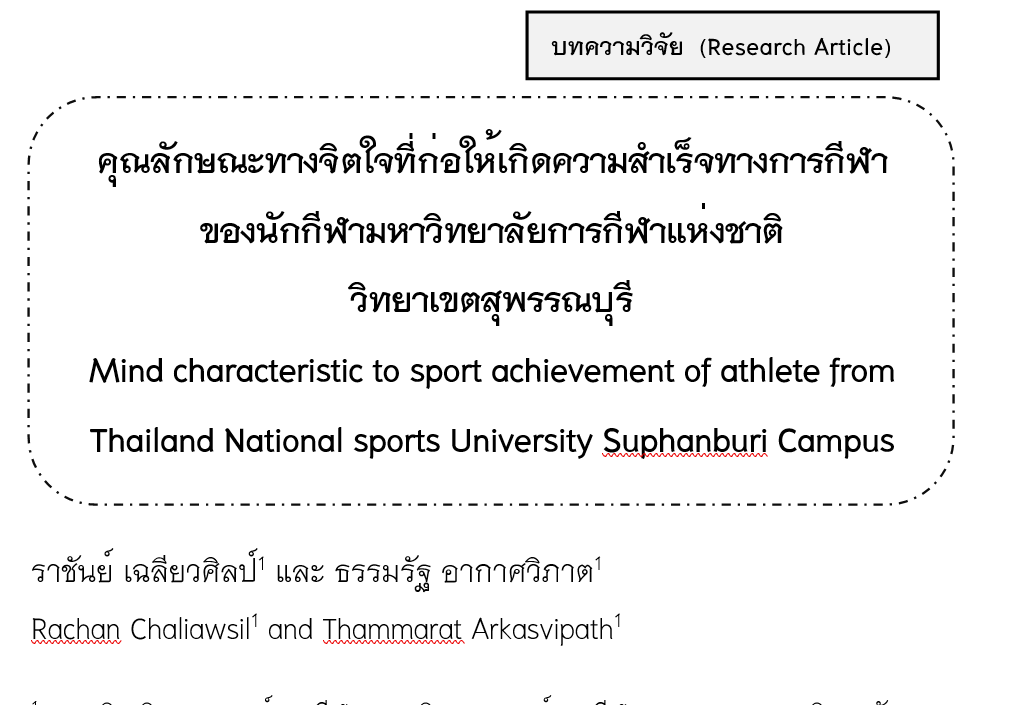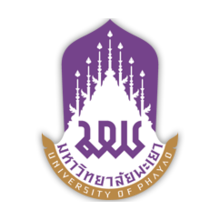Mind Characteristic to Sport Achievement of Athlete from Thailand National Sports University Suphanburi Campus
Keywords:
Mind Characteristic, Love, Earnestness and Proud of the Sport they are Participating, Reward and Being Famous, Self-Controlling for a Fully Ability of Development at the HigherAbstract
The research aimed to 1) study mind characteristic to sport achievement of athlete from Thailand National Sports University Suphanburi campus and 2) study relationship between mind characteristic to sport achievement of athlete from Thailand National Sports University Suphanburi campus. The samples of the study are 280 from Thailand National Sports University Suphanburi campus who are preparing to participate in the National Sports University game in 2021. The research instruments used in the study were measure of mind characteristic of sport successful; Cronbach’s alpha coefficient was 0.88. The statistics used for data testing were percentage, mean, standard deviation and Pearson Correlation Coefficient.
The results of the study were as follows:
1. The mind characteristic to sport achievement of athlete from Thailand National Sports University Suphanburi campus found that 1) love, earnestness, an a proud of the sport they are participating with the average at 33.68 point, in very high level 2) reward and being famous with the average at 33.68 point, in medium level and 3) self-controlling for a fully ability of development with the average at 40.88 point, in high level.
2. The analysis of relationship between mind characteristic to sport achievement of athlete from Thailand National Sports University Suphanburi campus, it was found that 1) love, earnestness and proud of the sport they are participating had the relationship with self-controlling for a fully ability of development at the higher lever (r=.769), 2) reward and being famous had the relationship with self-controlling for a fully ability of development at the higher lever (r=.700) and 3) love, earnestness, and proud of the sport they are participating had the relationship with reward and being famous at the moderate lever (r=.510) at a significant level of 0.01.
References
จิตรวี ซื่อสัตย์, ลิขิต บูรณชาติ, โสภา อำนวยรัตน์ และ น้ำฝน กันมา. (2564). คุณลักษณะภาวะผู้นำเชิงสร้างสรรค์ของผู้บริหารโรงเรียนมัธยมศึกษาที่ส่งผลต่อประสิทธิผลของโรงเรียนมัธยมศึกษาเขตภาคเหนือ สังกัดสำนักงานคณะกรรมการการศึกษาขั้นพื้นฐาน. วารสารมนุษย์ศาสตร์และสังคมศาสตร์ มหาวิทยาลัยพะเยา, 9(2), 14.
ฉัตรตระกูล ปานอุทัย. (2562). ผลการฝึกในภาวะพร่องออกซิเจนที่มีความหนักต่างกันที่มีต่อสภาวะอารมณ์และความสามารถในการใช้ออกซิเจนสูงสุด. (วิทยานิพนธ์ดุษฎีบัณฑิต สาขาวิชาวิทยาศาสตร์การออกกำลังกายและการกีฬา บัณฑิตวิทยาลัย). กรุงเทพฯ: มหาวิทยาลัยศรีนครินทรวิโรฒ.
ธนิดา จุลวนิชย์พงษ์, นฤพนธ์ วงศ์จตุรภัทร, และวิชัย จุลวนิชย์พงษ์. (2553). การพัฒนาแบบสอบถามความเข้มแข็งทางจิตใจฉบับภาษาไทย. วารสารวิทยาศาสตร์ออกกำลังกายและการกีฬา, 7, 1-14.
ธนิดา จุลวนิชย์พงษ์ และ ชัยวัฒน์ ชูสกุล. (2553). ความสัมพันธ์เชิงโครงสร้างของปัจจัยความเข้มแข็งทางจิตใจในนักกีฬาไทย. กรุงเทพฯ: ฝ่ายวิทยาศาสตร์การกีฬา การกีฬาแห่งประเทศไทย.
ธีระศักดิ์ อาภาวัฒนาสกุล. (2552). หลักวิทยาศาสตร์ในการฝึกกีฬา. กรุงเทพฯ: จุฬาลงกรณ์มหาวิทยาลัย.
นฤพนธ์ วงศ์จตุรภัทร, วิมลมาศ ประชากูล และ ชูศักดิ์ พัฒนะมนตรี. (2551). องค์ประกอบปัจจัยที่ส่งผลและแนวทางสร้างความเข้มแข็งทางจิตใจของนักกีฬาเซปักตะกร้อหญิงที่มีความสามารถสูง. ชลบุรี: ฝ่ายวิทยาศาสตร์การกีฬา การกีฬาแห่งประเทศไทย ร่วมกับคณะวิทยาศาสตร์การกีฬา มหาวิทยาลัยบูรพา.
นิกร สีแล. (2556). พื้นฐานวิทยาศาสตร์การกีฬา (พิมพ์ครั้งที่ 1). ชุมพร: ชุมพรปริ้นแอนดีไซน์.
ปณตนนท์ เถียรประภากุล. (2564). การพัฒนาทักษะการคิดขั้นสูงผ่านการสอนโดยใช้ห้องเรียนกลับด้านในรายวิชาปรัชญาการศึกษา. วารสารมนุษย์ศาสตร์และสังคมศาสตร์ มหาวิทยาลัยพะเยา, 9(2), 76.
พานิช ไชยศรี. (2534). หลักวิทยาศาสตร์ในการฝึกกีฬา. กรุงเทพฯ: กรมพลศึกษา.
วิชัย ยีมิน สุพัชริน, เขมรัตน์ และอภิลักษณ์ เทียนทอง. (2561) ปัจจัยทางจิตใจและยุทธวิธีทางจิตใจในช่วงการฝึกซ้อมของนักกีฬาฟุตซอลชั้นเลิศ: จำแนกตามตำแหน่งการเล่น. วารสารวิทยาศาสตร์และเทคโนโลยีการกีฬา, 18(1), 66.
สมบัติ กาญจนกิจ และสมหญิง จันทรุไทย. (2542). จิตวิทยาการกีฬาแนวคิดทฤษฎีสู่การปฏิบัติ. กรุงเทพฯ: จุฬาลงกรณ์มหาวิทยาลัย.
สำราญ สุขแสวง. (2560). การสร้างโปรแกรมการสร้างเสริมสมรรถภาพทางกายสำหรับนักมวยไทยอาชีพ. (วิทยานิพนธ์ศิลปศาสตรดุษฎีบัณฑิต สาขาวิชามวยไทยศึกษา บัณฑิตวิทยาลัย). ราชบุรี: มหาวิทยาลัยราชภัฏหมู่บ้านจอมบึง.
สุปราณี ขวัญบุญจันทร์. (2545). จิตวิทยาการกีฬา. กรุงเทพฯ: ไทยวัฒนาพาณิช.
สุพัชริน เขมรัตน์. (2562). จิตวิทยาการกีฬาพื้นฐานแนวทางการนำไปใช้. กรุงเทพฯ: มหาวิทยาลัยธรรมศาสตร์.
สุพิตร สมาหิโต. (2535). จิตวิทยาการกีฬากับโค้ช. กรุงเทพฯ: มหาวิทยาลัยเกษตรศาสตร์.
โสภิต สุวรรณเวลา, นฤมล ศิลวิศาล, วรารัตน์ ทิพย์รัตน์ และอนัญญา คูอาริยะกุล. (2562). ความวิตกกังวลและการจัดการความวิตกกังวลของผู้ปกครองที่มีบุตรป่วยเข้ารับการรักษา ในหอผู้ป่วยกุมารเวชกรรมโรงพยาบาลศูนย์ตรัง. วารสารวิทยาลัยพยาบาลบรมราชชนนีอุตรดิตถ์, 11(1), 55.
อาพรรณชนิต ศิริแพทย์. (2557). การจินตภาพทางการกีฬาแบบแพ็ทเลป(PETTLEP), วารสารวิทยาศาสตร์การกีฬาและสุขภาพ, 15(2), 1-12.
Burton, D. In R. N. Singer, M. Murphey & L. K. Tennant. (1993). Goal setting in sport. Handbook of research on sport psychology. New York: McMillian, 21.
Gill, D. L. (1986). Psychological dynamics of sport. Champaign, IL: Human Kinetics.
Locke, E. A., & Latham, G. P. (1975). A theory of goal setting and task performance. Journal of applied psychology, 60(3), 340.
Tabachnick, B. G., & Fidell, L. S. (1996). Using Multivariate Statistics (3rd ed.). New York: Harper Collins.

Downloads
Published
How to Cite
Issue
Section
License
Copyright (c) 2022 Phayao University

This work is licensed under a Creative Commons Attribution-NonCommercial-NoDerivatives 4.0 International License.
ผู้นิพนธ์ต้องรับผิดชอบข้อความในบทนิพนธ์ของตน มหาวิทยาลัยพะเยาไม่จำเป็นต้องเห็นด้วยกับบทความที่ตีพิมพ์เสมอไป ผู้สนใจสามารถคัดลอก และนำไปใช้ได้ แต่จะต้องขออนุมัติเจ้าของ และได้รับการอนุมัติเป็นลายลักษณ์อักษรก่อน พร้อมกับมีการอ้างอิงและกล่าวคำขอบคุณให้ถูกต้องด้วย
The authors are themselves responsible for their contents. Signed articles may not always reflect the opinion of University of Phayao. The articles can be reproduced and reprinted, provided that permission is given by the authors and acknowledgement must be given.






